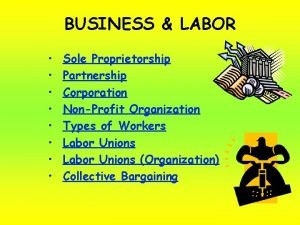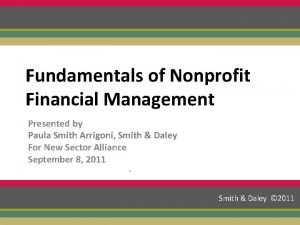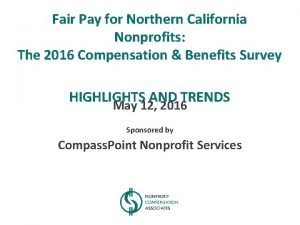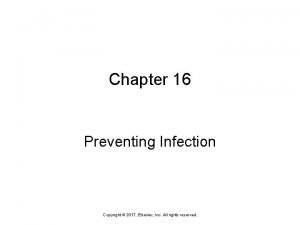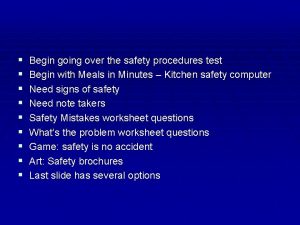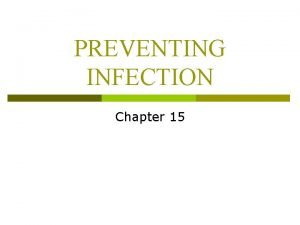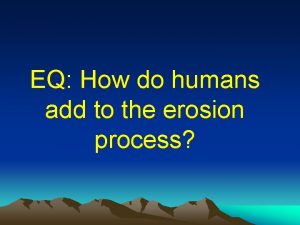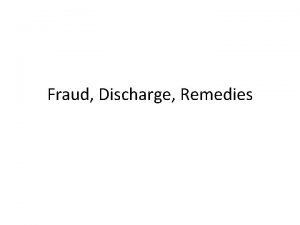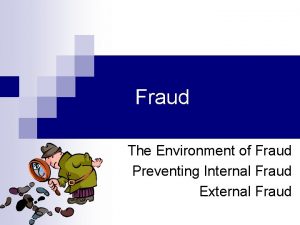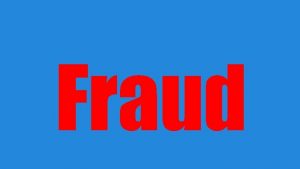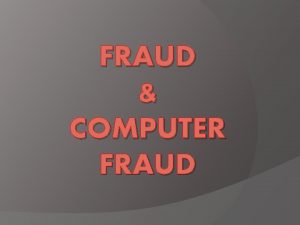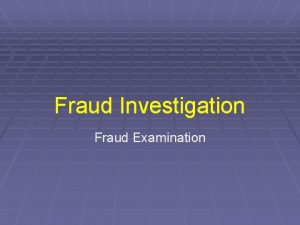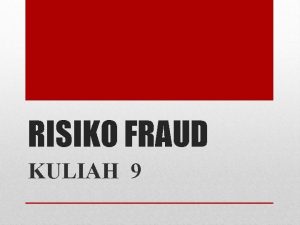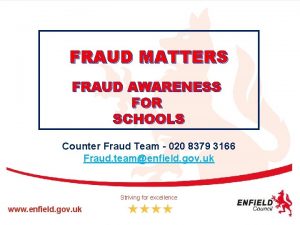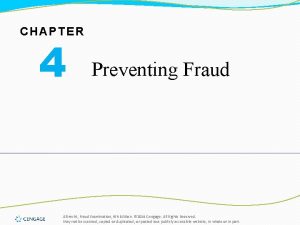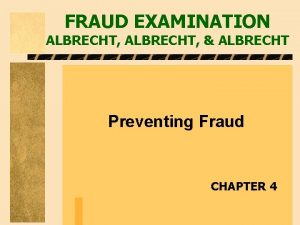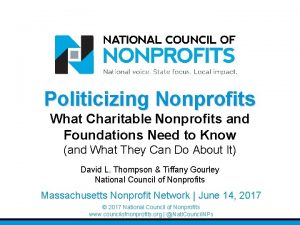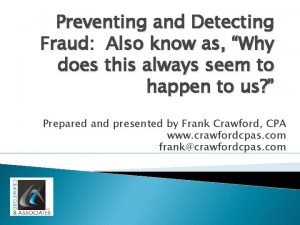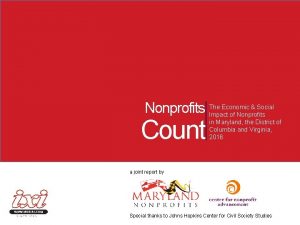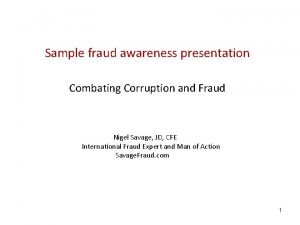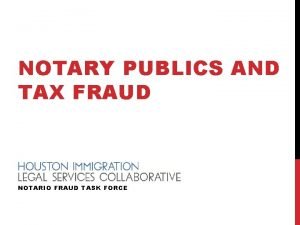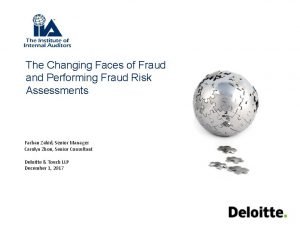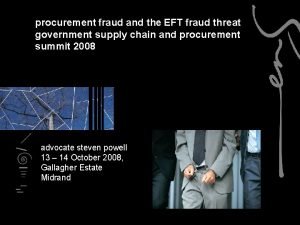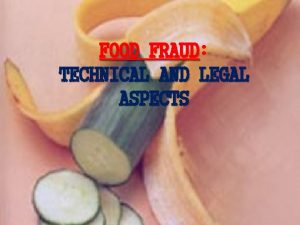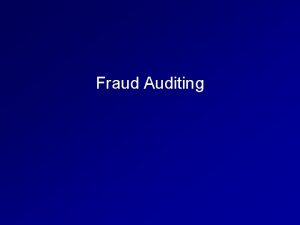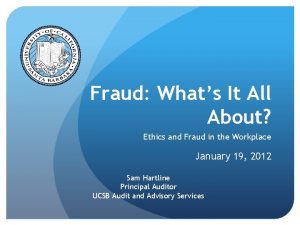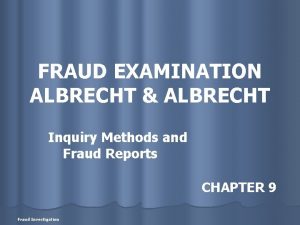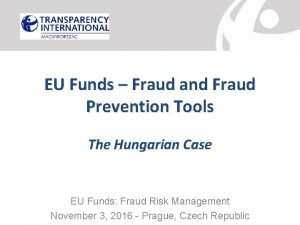Detecting and Preventing Fraud in Nonprofits Detecting and
























- Slides: 24

Detecting and Preventing Fraud in Nonprofits

Detecting and Preventing Fraud in Nonprofits Presented By: W. Andrew Powell, CPA Principal Halt, Buzas & Powell, Ltd.

Our Objectives for Today q Increase understanding of the types of fraud an organization may be most susceptible to q Improve awareness of the importance and application of an organization wide approach to protecting against fraud and abuse q What things your organization can implement to protect against fraud and abuse

Definition q Webster’s dictionary q The Association of Internal Auditors

Type of Fraud q Occupational § Definition – use of one’s occupation for personal enrichment through the deliberate misuse or misapplication of the employing organization’s resources or assets § Categories of occupational fraud >Asset misappropriations >Corruption >Fraudulent statements

ACFE q Association of Certified Fraud Examiners (ACFE) q Every two years issues a “Report to the Nation” dealing with Occupational Fraud q The 2006 results are from a study of data from 1, 134 cases of fraud

2006 ACFE “Report to the Nation” 147 Cases involving NFPs, schemes included:

2006 ACFE “Report to the Nation” How fraud was detected NFP ALL Tip 34. 4% 34. 2% Accident 28. 7% 25. 4% Internal audit 16. 4% 20. 2% Internal control 19. 7% 19. 2% External audit 14. 8% 12. 2% 4. 9% 3. 8% Notified by police

2006 ACFE “Report to the Nation” What type of anti-fraud measures existed in the organizations External Audit 104 Internal Audit 67 Fraud Training 50 Surprise audits 47 Hotline 33

2006 ACFE “Report to the Nation” Of all the 1, 134 cases in the 2006 study: q 23. 4% resulted in 25% or less in recovery amount q 18. 1% resulted in 26% to 75% of recovery amount q 16. 4% resulted in 100% of recovery amount q 42. 1% resulted in no recovery

Factors Present in All Frauds q Opportunity q Intent q Motive q Concealment q Rationalization

Why is an Organization Susceptible to Fraud q Financial condition of the organization q Pressure to present results for funders and general public q Internal accounting controls q Integrity level of corporate leaders and employees q Commitment to organizations value system q Reward systems for ethical behavior

Why is an Organization Susceptible to Fraud (cont’d) q Personal traits and characteristics of executives and employees q Organizational culture and dynamics q Peer pressure q Perception of detection q Swiftness, certainty, and severity of punishment

Other Types/Forms of Fraud q Types: § Investment scams § Vendor § Customer q Forms: § § § Theft of intellectual property Check and credit card fraud Money laundering Computer and internet Contract and procurement Identity theft

Characteristics that Open up a NFP to Fraud q Environment of trust q Excessive control by founder, exec director, major contributor q Board of Directors lacking financial expertise q Existence of nonreciprocal transactions q Lack of resources for financial management q Job security linked to program and financial reporting (especially an org with gov’t grants)

Types of Fraud in NFPs q Ghost employees q Sub recipient fraud q Expense reimbursements q Skimming of charitable contributions q Financial assistance q Founder/leader syndrome q Fundraising

Cost of Fraud to NFP q Reputation impact § § Program management Personnel recruitment Fundraising Overall image q Employee morale q Actual loss of assets or resources q Insurance coverage q Investigative and prosecution costs q Corrective action

How does a NFP Cope q Acknowledge that fraud and abuse is an organization issue q Establish a practice of periodic risk management as it relates to fraud and abuse q Develop an organizational model for controlling fraud and abuse

How does a NFP Cope q Organizational facts: § Everyone in the organization has a role in detection and prevention § Traditional internal accounting controls play a role § Primary reliance on the external audit is not enough

How does a NFP Cope q Organizational facts (cont. ): § People and circumstance change over time, which may increase the risk § The real cost, once discovered, can not be measured in terms of dollars § A probability exists that some level of fraud or abuse may already exist or could happen in the near future

How does a NFP Cope q Risk management activities: § Assessment § Reduction § Transfer § Acceptance

How does a NFP Cope q Organizational model for controlling fraud § Establish appropriate financial controls as related to opportunities to commit fraud § Establish non-financial systems to deal with fraud risk factors § Establish a tone at the top relating to fraud

Other q Experiences to share q Additional comments

Questions? W. Andrew Powell, CPA Principal Halt, Buzas & Powell, Ltd. (703) 836 -1350 apowell@cpas 4 you. com
 How do fraud symptoms help in detecting fraud
How do fraud symptoms help in detecting fraud Mpower crm
Mpower crm Kahoot for nonprofits
Kahoot for nonprofits Finance fundamentals for nonprofits
Finance fundamentals for nonprofits Fair pay for northern california nonprofits
Fair pay for northern california nonprofits Digital ecosystem map
Digital ecosystem map Chapter 24 lesson 2 preventing and treating stds
Chapter 24 lesson 2 preventing and treating stds Chapter 9 resolving conflicts and preventing violence
Chapter 9 resolving conflicts and preventing violence Chapter 14:1 using body mechanics
Chapter 14:1 using body mechanics Chapter 9 resolving conflicts and preventing violence
Chapter 9 resolving conflicts and preventing violence Chapter 13:2 preventing accidents and injuries
Chapter 13:2 preventing accidents and injuries Chapter 20 preventing kitchen accidents
Chapter 20 preventing kitchen accidents Chapter 16 preventing infection
Chapter 16 preventing infection Preventing kitchen accidents worksheet
Preventing kitchen accidents worksheet Johannes volkelt theory
Johannes volkelt theory Chapter 4 preventing injuries through fitness
Chapter 4 preventing injuries through fitness Chapter 15 preventing infection
Chapter 15 preventing infection Preventing hand injuries
Preventing hand injuries Preventing cuts
Preventing cuts Preventing ageing unequally
Preventing ageing unequally Which is mainly responsible for preventing erosion
Which is mainly responsible for preventing erosion Sniffer for detecting lost mobiles
Sniffer for detecting lost mobiles Detecting evolutionary forces in language change
Detecting evolutionary forces in language change Golden ticket active directory
Golden ticket active directory Havex
Havex


